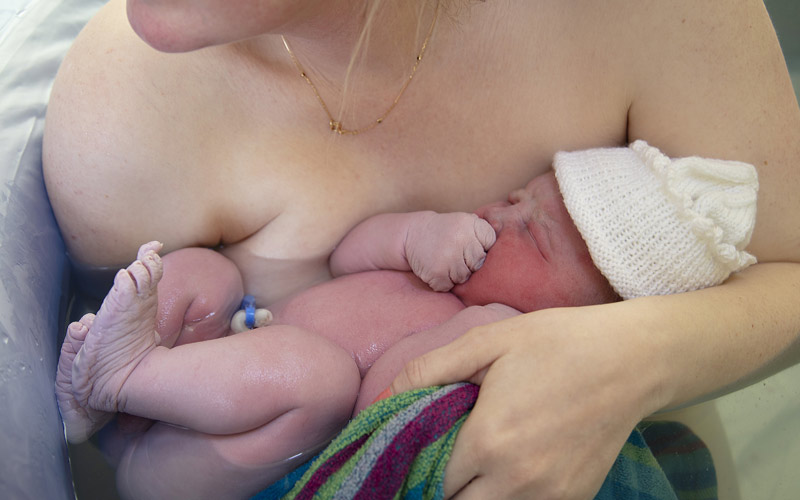Water Birth 101 With a Birth Educator

Have your sights set on bringing baby into the world via water birth? Unlike Hollywood depictions of labor and delivery where moms are uncontrollably wailing in excruciating pain, water immersion and hydrotherapy practices can offer women a more relaxing experience overall and the possibility of an enjoyable birth experience.
But because delivery isn’t a one-size-fits-all kinda thing, we enlisted the expertise of Sara Lyon, doula and birth educator, two-time author and the founder of Glow Birth & Body, for a better understanding of the benefits of water birth and how a mom-to-be can know if it’s the right choice for her.
1| What are the benefits of water birth?
Studies consistently show that birthing in water contributes to higher satisfaction in birthing moms, which isn’t surprising when you know the documented gains of reduced pain, shorter labor and reduced tearing.
Water provides buoyancy and tactile distraction from the intensity of labor, and simultaneously softens the perineum in preparation for birth. This buoyancy is incredibly relieving after months carrying extra weight, and potentially hours on your feet in labor. This newfound weightlessness allows for easier pelvic movement, like squatting and rotating the hips while submerged, so the baby can move down through the pelvis with more ease.
2| How does it help with pain relief?
Certain kinds of soothing tactile stimuli, like massage and warm water, inhibit our perception of pain through spinal nerve conduits. Warm water on the skin stimulates specific nerve fibers that reduce pain. When combined with mindfulness practices, immersion in water can be as powerful as analgesics.
It’s also important to note the difference between water labor and water birth because there are perks to both. For example: laboring in water can reduce the pain of labor, the length of labor and it will prepare the perineum for birth, even if you transition to the dry ground or the bed to push. But birthing in water will further reduce tearing and episiotomies because women are more likely to birth in an upright position, as opposed to lithotomy (on the back).
3| Who is a good candidate for this type of delivery?
Anyone with a low-risk pregnancy without complications (such as a breech baby or preeclampsia) is a good candidate for water birth, and with health care providers (whether an OB-GYN or nurse-midwife) who are supportive of laboring and birthing in water. For any mom trying to determine what type of birth she wants or is comfortable with, research is always a great place to start. Websites like Evidence Based Birth provide data-driven resources for your understanding of the risks and benefits associated with different options, so you can make an informed decision.

4| Why do some birth facilities not allow tub births?
Unlike birthing centers, most American hospitals aren’t investing in non-medical tools to help women labor comfortably; bathtubs and birthing pools don’t make money, but they do require more space and care to maintain safely. Underfunded birth facilities often don’t have enough room for birthing tubs in their tight labor and delivery wards, so water birth frequently comes with privilege and the ability to afford a home birth or insurance that affords a private birthing suite in an affluent hospital.
Birth and labor in water is also more challenging for the medical providers’ bodies. Throughout the first and second stage of labor, the nurse or midwife needs to intermittently, manually check the baby’s heart rate, which means getting onto the ground, arms in the water, searching for the heartbeat. During the pushing and birth phase, they have to be on their knees, crouching, with someone else holding a light so they can adequately see, sometimes for an hour or more.
It’s physically intense, and many practitioners simply won’t do it, but none of that has to do with the safety of water and of the mother or baby. Separately, our society’s litigious approach to obstetrics deters institutions from taking perceived risks, such as the use of water, even if evidence doesn’t support those decisions.
The good news is that other kinds of hydrotherapy are also immensely helpful, so don’t lose hope if you don’t have access to a tub come baby’s due date. You can use a birth ball in the shower in lieu of a birth pool, allowing you to sit and use movement and massage techniques. (Just watch your body temperature and make sure the water isn’t too hot.) Outside of the shower, use washcloths with hot or cold water placed on the forehead, nape of the neck or lower back. The tactile effects of water will still help with pain management.
5| What are the potential risks to neonatal outcomes?
There are very few documented risks of water birth to the baby. While a small number of incidents of infection exist, it’s no more prevalent than in “land” births.
When it comes to baby’s ability to breathe underwater, it is extremely rare that a newborn tries to breathe air before surfacing the water. (They’re used to living in amniotic fluid, after all.) In the few documented cases of respiratory distress due to water aspiration, the babies recovered completely.
Another concern is what happens if baby poops. If meconium is present, the medical team will monitor the baby more closely, requiring the mama to move out of the water. The team will first use continuous monitors if they haven’t been thus far in the labor, and that could include a fetal scalp electrode (FSE). The FSE gives the most accurate and reliable reading of the heart rate.
6| How do I best prepare for a water birth?
If you’re birthing in a hospital or birth center, you’ll prepare for a water birth just as you would for a land birth with classes and a detailed birth plan and forming a supportive team you trust.
If you’re birthing at home, you’ll rent a birth tub, test the piping with your sink faucet prior to the onset of labor, and discuss your birth plan with your midwives. Bear in mind that you cannot have an epidural and have a water birth, so your preparation should include an array of comfort techniques, from breathwork to laboring positions to mindfulness practices and more.
Another tip is to talk with other moms who have had successful, positive experiences with water birth. I’ve used water in both of my own births, one for labor, and the other for labor and birth. In both cases, I felt so much lighter and more comfortable in the water. My contractions slowed, but I dilated much faster in the water than on land. My contractions were just more efficient in labor, probably because I was more relaxed and had higher levels of the pro-contraction hormone oxytocin.
I birthed out of the water in my first birth, and I had a pretty significant tear. During my second birth, this time in water, I didn’t have any tearing or bruising. (I could have ridden a bike the next day!) It’s common for second and subsequent births to cause less injury, but the difference was remarkable, even to my midwives.
Birth is a beautifully intense process regardless of the method you choose to pursue. If you’re looking to prioritize relaxation and create a calmer environment for your body and mind, utilizing water may be a great fit for you.







